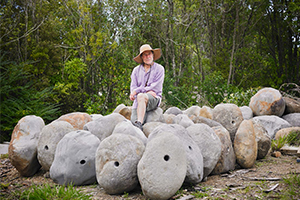
Culture Etc.

Above: Chris Booth at Nga Uri o Hinetuparimaunga (2005), Hamilton Gardens, Hamilton.
The Alchemist
He’s responsible for some of our largest, most recognisable and enduring public artworks, but sculptor Chris Booth has spent much of his prolific career flying just below the radar. Kerikeri’s hardest working retiree isn’t slowing down any time soon.
By Garth Cartwright
I find Chris Booth in a field north of Kerikeri studying piles of boulders. To me, the grey granite stones all look the same but to Booth, who is busy measuring and contemplating, these are what fire his imagination and have seen him described by leading British art critic Edward Lucie Smith as “a poet of the natural world”. Put simply, Booth is an art alchemist, transforming the boulders, rocks, pebbles, slate, driftwood, tree trunks, branches, flax, and fungi most of us ignore into monumental sculptures.
“I love this one,” he says, tapping a huge chunk of granite. “But it’s too big. Likely weighs five ton. And my crane can only lift three.” It appears even an alchemist has to know his limitations. Then he’s off again, the hunter-gatherer in search of more materials to work with, his energy levels and fitness remarkable for a man who will soon turn 73 and has worked with heavy objects for more than 50 years.
While you may not immediately recognise Booth’s name, it is likely you have seen his sculptures. Perhaps you’ve walked past Gateway, whose twin columns of boulders joined by an arc of steel cables stand at the corner of Albert Park and Victoria Street in Auckland’s CBD. Or maybe you’ve visited the Rainbow Warrior Memorial (a work which “almost bankrupted” Booth in its making). Situated on a tor at Matauri Bay overlooking the last resting place of the Greenpeace ship, it is one of New Zealand’s most striking creations, this stone rainbow with the ship’s propeller attached, sitting high above the South Pacific ocean. You also might have encountered Nga Uri O Hinetuparimaunga at the entrance to Hamilton Gardens: a wall of 21 massive stone columns with a kākahu (cloak) created by Māori weaver Diggeress Te Kanawa out of pebbles. There are many other Booth sculptures scattered across New Zealand — all are remarkable, and none quite the same.
I’ve known Booth since the mid- 1980s and what most characterises him, beyond his gentle, friendly nature, is an obsessive need to sculpt. Thus he perseveres with making art that is challenging to both build and fund. Endlessly fascinated with our remarkable natural world, Booth weaves stones as others do words.
From art openings to a hui on a marae to the local rugby club, Booth moves easily among people, always engaged and interested. That said, his calm demeanour was tested recently: a forthcoming public sculpture (Te Haa o Te Ao — Breath of the World; due for unveiling in July) to be situated at Kerikeri’s main traffic intersection sparked a kerfuffle in 2020. Some residents were opposed, causing enough of a stir that a news crew even turned up to canvas the conflict, interviewing Booth before asking locals whether “$550,000 of taxpayer money [should] be spent on a sculpture?” The response, if you were to believe the 6pm news that night, was an almighty “No!”
“It always hurts when people react without thinking or researching,” Booth tells me. “People seem to think I’m pocketing half a million dollars that the government has gifted me — this is not the case.” The money was allotted from the Provincial Growth Fund to encourage investment in rural communities. “Every cent of that money gets ploughed back into the community — local contractors, engineers, workers.” Fortunately for Booth he had local iwi on his side, who managed to turn things around. Members of Ngāti Rēhia met with leaders of the anti-sculpture sentiment to explain why they supported the sculpture and how the work relates to the natural world. “After that the main protagonist went on to support the project,” Booth says.
As with many of Booth’s works, his Kerikeri sculpture involves intensive engineering and foresight (works in Kaikoura and Christchurch withstood earthquakes). If his visions sound outlandish on paper — a stone rainbow! A pebble blanket! — ever since dropping out of the University of Canterbury’s Ilam Art School at 19 and taking a boat to England, Booth has proved himself more than capable of making the impossible look easy.
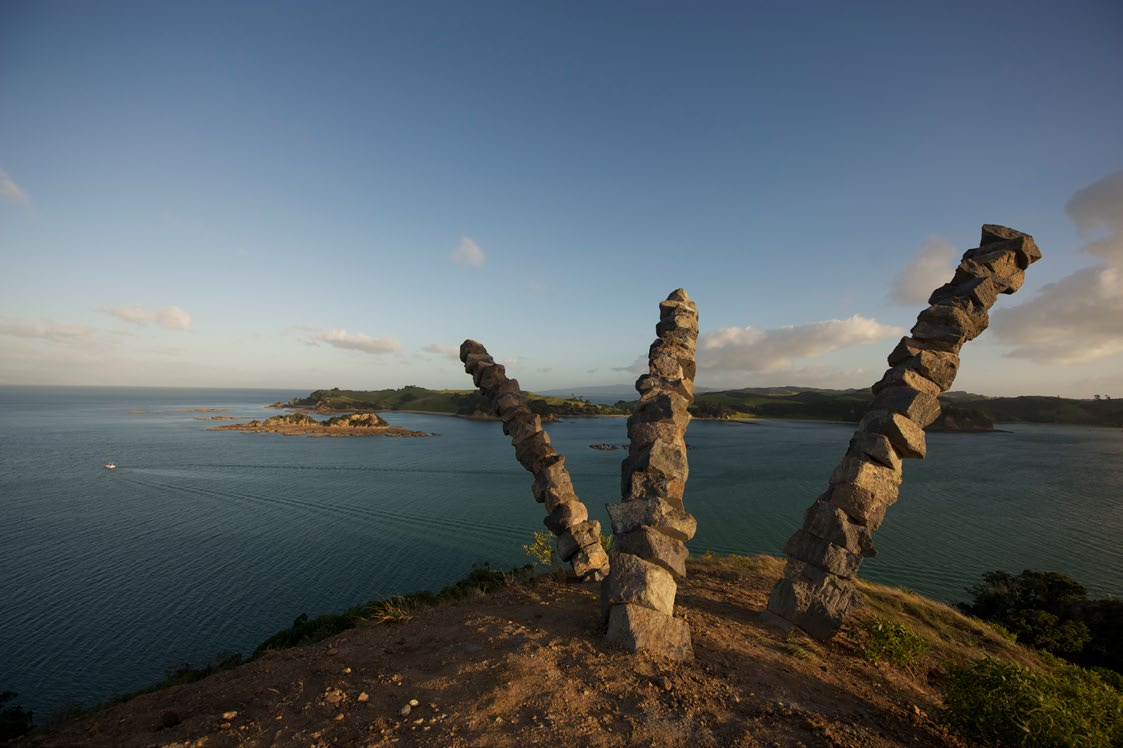
Kaitiaki, (2010–2011), Rotoroa Island.
Born to an English father and Kiwi mother in Kerikeri, Booth and his three siblings grew up on an orchard that was organic before the term was invented. Raised to love the land and sea, the Booth boys also grew up in what was then a strongly bicultural environment.
“In the old days, Kerikeri was very much a mixed Māori-Pākehā community,” says Booth. It was a village then, and a small one. Then, in the 1970s, developers began promoting Kerikeri as a retirement community, which “radically changed everything”. Now, its population has a much lower proportion of Maori than neighbouring parts of Northland, and so many retirees continue to move there that a recent Stuff article asked whether Kerikeri was “the retirement mecca of New Zealand”. As a high school student, Booth attended Northland College in nearby Kaikohe, where the roll was 75 per cent Māori at the time. Selwyn Te Ngareatua Wilson, Booth’s art teacher, was inspirational he says. The ongoing support Booth receives from Northland iwi stems from here, informing a lifelong engagement with Māori communities dating back to long before it was considered correct protocol for art institutions.
Working outside New Zealand, too, Booth ensures he has the blessings of local communities and indigenous people when making work — Aboriginal people in Australia, Native Americans in North America, and long-settled communities in rural England, Italy, Germany and elsewhere. “I hate the idea of the ‘superman-artist’ coming in and dictating what will be built,” he says. “I believe in consultation and mutuality.”
A news crew turned up to canvas the conflict, asking locals whether “$550,000 of taxpayer money [should] be spent on a sculpture?” The response, if you were to believe the 6pm news that night, was an almighty “No!”
If Kerikeri was a provincial backwater, it provided Booth with a grounding in both art and the natural world. “Dad made his own tools and literally did everything with nature — he set up his orchard in the 1930s and never sprayed like everyone else did,” Booth says. “And Mum loved to paint. She saw that art was my strength from when I was about eight years old and encouraged me all the way.”
Realising Ilam was too formal to teach him what he wanted, Booth headed to St Ives, Cornwall, determined to study under the renowned British sculptor Dame Barbara Hepworth, whose abstract works were rooted in the natural world, an inspiration to Booth. Upon arriving, he knocked on Hepworth’s door and announced his wish, adding that he would, in exchange, work for free in her studio. She informed the young Booth that she already had three full-time assistants but, impressed by his verve, recommended him to her neighbour, abstract sculptor John Milne. Booth made good use of his time in St Ives (now a tourist resort, back then England’s foremost artistic community) with Hepworth offering encouragement and advice. He even sold early works to local museums. After 20 months there (and four more working at a foundry in Italy), he joined the hippie trail to India, driving overland (via Yugoslavia, Turkey, Iran, Pakistan) in a Mini with his brother Webber, before returning to Kerikeri in 1970 aged 22. Here he first lived in a disused cowshed on the family’s orchard as he set about establishing himself as a sculptor.
Recognition came slowly — Booth has never made art that could easily be hung on the walls of collectors’ villas — and he worked as a school bus driver alongside his art practice, collecting children from outlying Māori communities. The inequality and injustice he observed doing so would lead him to volunteer on the Māori Land March in 1975 —through this he formed a long friendship with the poet Hone Tuwhare. When Tuwhare died, his family requested that Booth carve his headstone.
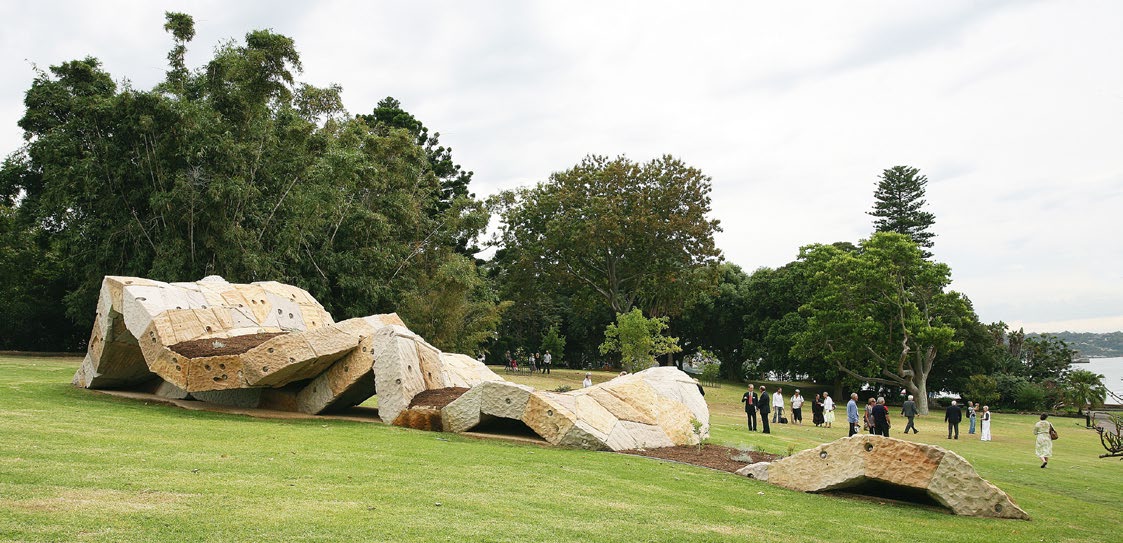
Wurrungwuri (2008– 2010), Sydney, Australia.
The late-1970s found Booth shifting to Auckland and working as a set designer at the Mercury Theatre while becoming part of the influential art dealer Denis Cohn’s stable. His work began to enter museum collections and led to him being awarded the 1982 Frances Hodgkins fellowship. Based in Dunedin for a year, Booth was mentored by painter Ralph Hotere, who welcomed the younger artist. Both Hotere and Tuwhare were Northland born and Booth describes their friendship as that of “Tai Tokerau kindred spirits”. He speaks with great warmth and humour of his late friends, Hotere having encouraged Booth to build his first monumental sculpture (Aramoana, protesting against a proposed aluminium smelter) on his Port Chalmers property. Hotere was a great man, Booth says. “I’d never had the space to build a really large sculpture before,” he explains, “and when I outlined my idea for one Ralph told me to build it on his property. So I did. He gave me a lot of encouragement.”
The fellowship proved to be a turning point in Booth’s career. The work he produced in Dunedin led to the Dowse in Upper Hutt hosting a survey show, and resulted in commissions from the National Gallery, Auckland City Art Gallery and the Auckland Stock Exchange Building. Then he won the commission to create Albert Park’s Gateway. He was then invited by Dover Samuels (prior to his career as a Labour MP) to build the Rainbow Warrior Memorial in 1988. Unlike a lot of 1980s artists — an era dominated by showy, postmodern creations — Booth engaged the viewer with the natural world and environmental concerns. This won him international attention: he spent much of the 1990s and early 2000s working across Australia, North America, Japan, Mexico and Europe. Canadian author and curator John Grande observed that “while Booth’s sculptures sometimes draw upon indigenous Māori and Aborigine characteristics, they remain unique, and capture aspects of topography, natural history, and landscape forms already extant in the places he works.”
Booth describes his friendship with Ralph Hotere and Hone Tuwhare as that of “Tai Tokerau kindred spirits”.
Praise for his work doesn’t only come from critics. In an art world riven with rivalry and back stabbing, it’s rare to hear a bad word said about Booth. I asked Fatu Feu’u, the noted Samoan painter and sculptor, to tell me about Booth. “Chris is a very innovative sculptor,” he says with a broad smile. “I met him at least 35 years ago and I’ve come to realise he’s also a really good man. He’s respectful of other cultures and always willing to help younger artists — with Chris there’s no ego, he’s never boastful, he’s always interested in everyone else.” Not so many successful artists are like that, Feu’u says, and it’s an example others should follow. He says that Booth’s international sculptures have put New Zealand on the art map, calling it “really stunning work”.
Booth’s success found him the subject of three books of text and photography: Chris Booth Sculpture (1991), Chris Booth – Sculpture in Europe, Australia & New Zealand (2001) and Woven Stone (2007). The latter, written by Booth as a visual autobiography, is to my mind the best monograph yet on a Kiwi artist. In it, photos from across his life sit alongside striking images of his sculptures and Booth’s plainspoken yet informative text, giving a real sense of the artist’s life.
But if international success and widespread acknowledgement encompassed Booth’s middle age, decades of hard toil have now made their mark. He’s ripped his rotator cuffs in both shoulders, needed a hip replacement and done “all sorts of damage” to his body. “I’ve always tried to do things properly using levers, rollers and a crane, but the heavy nature of my work means damage has been done.” He grimaces then smiles and adds, “I’m like an old athlete.”
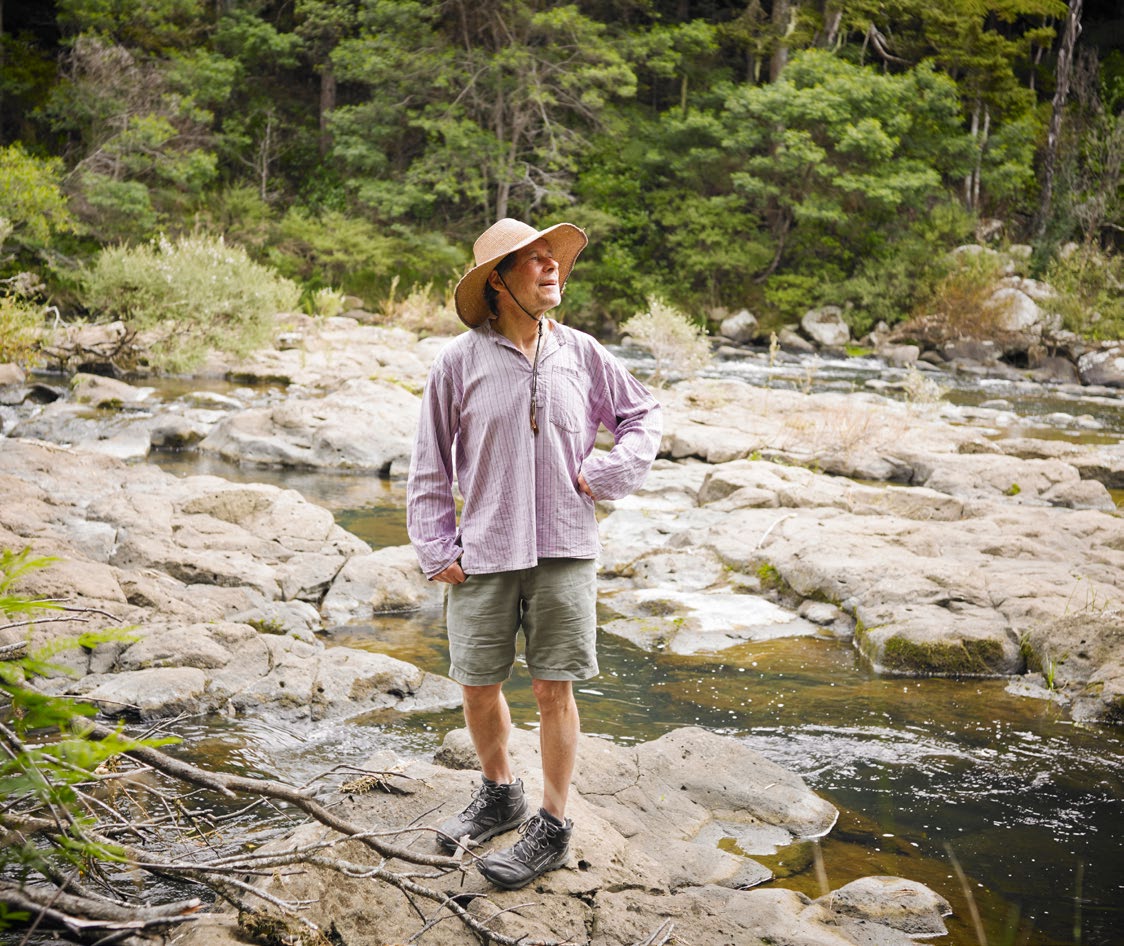
Chris Booth by a Kerikeri riverbed. Photo: Victoria Birkinshaw.
Booth has largely based himself in Kerikeri over the past decade, having recognised the contradiction of being an environmentalist who was constantly globetrotting. International demand continues — he was this year’s Featured International Artist in Perth’s Sculpture By The Sea symposium — but he now tends to build at his home studio. A suggestion by his wife, Anne-Marie, that he create smaller sculptures that could be sold to collectors — and raise much-needed funds for his more ambitious works, which he has struggled to find sponsors for — was vetoed. He feels he was simply born to make large-scale work.
“When I had my hip replacement I was out of action for several months and attempted to make small works. I just couldn’t do it.” Like many a visionary, Booth is incredibly hard-headed. “Barbara Hepworth told me, ‘You won’t get anywhere if you don’t gamble’, so I’ve gambled all my life,” he says. “I just borrow the money and get on with it. But we’ve been in terrible debt at times, and lockdown last year exacerbated that when some wealthy patrons used it as an excuse to cancel sculptures I had been in the planning stages of.”
For a man who has been entitled to claim his pension since 2013, surely this plus the televised complaints about his new sculpture, the labour-intensive work and the huge overheads must on occasion make him feel like retiring?
“The only thing that makes me feel like putting my feet up is dealing with the clients who tax your frustrations,” he says. “I love what I do.”
Indeed, Booth’s adobe house, built on the family’s former orchard, surrounded by fruit trees and close to the river, is an oasis of peace and creativity. Here the artist as an elder plans ever more holistic art works, his love of nature and art powering through him. Long may Kerikeri’s native son continue to share his visions. And let’s hope the locals come around too.
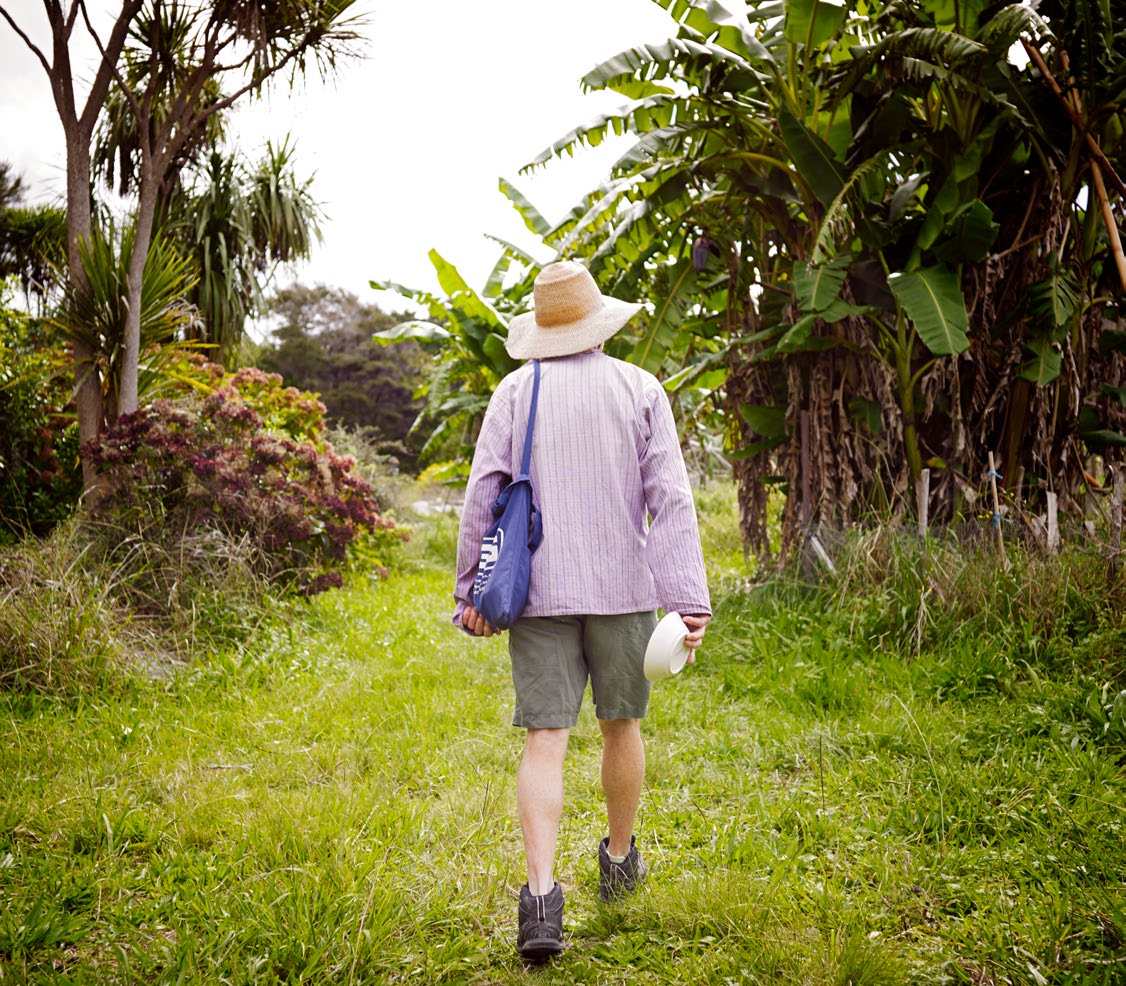
Booth near his home in Kerikeri. Photos: Victoria Birkinshaw.
Garth Cartwright is an Auckland-born, London-based journalist and author.
This story appeared in the July 2021 issue of North & South.
